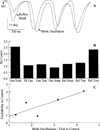Dry eye, blinking, and blepharospasm
- PMID: 11836761
- PMCID: PMC3327285
- DOI: 10.1002/mds.10065
Dry eye, blinking, and blepharospasm
Figures


Similar articles
-
Sex, blinking, and dry eye.J Neurophysiol. 2020 Feb 1;123(2):831-842. doi: 10.1152/jn.00635.2019. Epub 2020 Jan 15. J Neurophysiol. 2020. PMID: 31940243
-
Blink reflex studies in postparalytic facial syndrome and blepharospasm: trigeminal and extratrigeminal somatosensory stimulation.J Clin Neurophysiol. 2014 Dec;31(6):535-40. doi: 10.1097/WNP.0000000000000095. J Clin Neurophysiol. 2014. PMID: 25462139
-
Blink reflex in patients with postparalytic facial syndrome and blepharospasm: trigeminal and auditory stimulation.Clin Neurophysiol. 2013 Jan;124(1):120-5. doi: 10.1016/j.clinph.2012.05.027. Epub 2012 Jul 31. Clin Neurophysiol. 2013. PMID: 22854209
-
Blepharospasm: report of a workshop.Neurology. 1996 May;46(5):1213-8. doi: 10.1212/wnl.46.5.1213. Neurology. 1996. PMID: 8628455 Review. No abstract available.
-
Ophthalmologic causes of blepharospasm.Adv Neurol. 1988;49:91-102. Adv Neurol. 1988. PMID: 3278557 Review. No abstract available.
Cited by
-
A Dynamic Circuit Hypothesis for the Pathogenesis of Blepharospasm.Front Comput Neurosci. 2017 Mar 7;11:11. doi: 10.3389/fncom.2017.00011. eCollection 2017. Front Comput Neurosci. 2017. PMID: 28326032 Free PMC article.
-
Assessment of corneal epithelial thickness in dry eye patients.Optom Vis Sci. 2014 Dec;91(12):1446-54. doi: 10.1097/OPX.0000000000000417. Optom Vis Sci. 2014. PMID: 25279779 Free PMC article.
-
Asymmetry of blinking.Invest Ophthalmol Vis Sci. 2006 Jan;47(1):195-201. doi: 10.1167/iovs.04-1279. Invest Ophthalmol Vis Sci. 2006. PMID: 16384962 Free PMC article.
-
Characterizing the spontaneous blink generator: an animal model.J Neurosci. 2011 Aug 3;31(31):11256-67. doi: 10.1523/JNEUROSCI.6218-10.2011. J Neurosci. 2011. PMID: 21813686 Free PMC article.
-
Animal models for investigating benign essential blepharospasm.Curr Neuropharmacol. 2013 Jan;11(1):53-8. doi: 10.2174/157015913804999441. Curr Neuropharmacol. 2013. PMID: 23814538 Free PMC article.
References
-
- Korb DR, Baron DF, Herman JP, Finnemore VM, Exford JM, Hermosa JL, Leahy CD, Glonek T, Greiner JV. Tear film lipid layer thickness as a function of blinking. Cornea. 1994;13:354–359. - PubMed
-
- Tseng SCG, Tsubota K. Important concepts for treating ocular surface and tear disorders. Am J Opthalmol. 1997;124:825–835. - PubMed
-
- Bron AJ, Tiffany JM. The meibomian glands and tear film lipids. Structure, function and control. Adv Exp Med Biol. 1998;438:281–295. - PubMed
-
- Tutt R, Bradley A, Begley C, Thibos LN. Optical and visual impact of tear break-up in human eyes. Invest Ophthalmol Vis Sci. 2000;41:4117–4123. - PubMed
-
- Peshori KR, Schicatano EJ, Gopalaswamy R, Sahay E, Evinger C. Aging of the trigeminal blink system. Exp Brain Res. 2001;136:351–363. - PubMed
Publication types
MeSH terms
Grants and funding
LinkOut - more resources
Full Text Sources
Other Literature Sources

